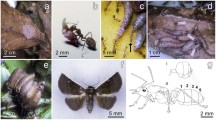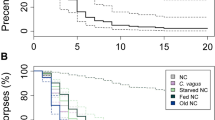Summary
-
1.
The myrmecophilic beetle Atemeles pubicollis Bris, changes its hosts obligatorily twice in its imaginal life: after emergence in July/August in the nest of the larvae-host Formica the beetle moves to Myrmica and returns to Formica after hibernation. Observations by Wasmann were confirmed in the field and in the laboratory.
-
2.
2–3 days of positive phototaxis and high activity take the beetles, 6–9 days after emergence, from the forest habitat of Formica to the open grassland nesting sites of Myrmica.
-
3.
The beetles are attracted by the specific odour of Myrmica-nests; running clinotactically upwind they are guided to their host's nests.
-
4.
The odour of the Myrmicine genera (Tetramorium, Solenopsis) attracts the guests also; however in an alternative choice situation Myrmica is always preferred. The odour of this species is even detected if it is offered in a mixture with the odour of other ants.
-
5.
The beetles readiness to react to the Myrmica odour lasts only two weeks after leaving Formica.
-
6.
During this time they are adopted by Myrmica: The guests do not actively intrude into their host's nest, but wait in front of the nest entrances until the ants carry them in.
-
7.
This interest in adoption is induced in the ants by a secretion from the unicellular glands along the margins of the abdominal tergites. This secretion is only effective in host ants. In addition, pygidial gland secretion has a calming effect on the ants and another abdominal gland produces a repellent.
-
8.
By using radioactive tracer (32P) it could be shown that the beetles participate parasitically in the ants food exchange in the nests of Formica and in those of Myrmica.
Zusammenfassung
-
1.
Der Ameisengast Atemeles pubicollis Bris, wechselt zweimal obligatorisch seinen Wirt: Nach dem Schlüpfen (Juli/August) vom Larvenwirt Formica zu Myrmica und nach der Überwinterung zurück zu Formica. Freilandbeobachtungen von Wasmann wurden bestätigt und in Laboratoriumsversuchen bewiesen.
-
2.
Eine 2–3 Tage dauernde Hellstimmung und hohe Bewegungsaktivität treiben die Käfer am 6.–9. Tag nach dem Schlüpfen aus dem Waldbiotop der Formica-Wirte in den Wiesenbiotop der Myrmica-Wirte.
-
3.
Ein spezifischer Duft der Myrmica-Wirte löst, gekoppelt mit positiver Anemotaxis, ein klinotaktisches Suchverhalten aus und führt die Käfer zu den Myrmica-Nestern.
-
4.
Auch durch Düfte anderer Myrmicinen-Arten (Tetramorium, Solenopsis) werden die Käfer angelockt. Im Alternativtest dominiert Myrmica-Duft vollständig. Die Atemeles erkennen den Myrmica-Duft auch dann noch, wenn er mit anderen Ameisendüften gemischt geboten wird.
-
5.
Die Käfer sind nur ca. 14 Tage lang nach dem Verlassen des Formica-Nestes in Stimmung, auf Myrmica-Duft zu reagieren.
-
6.
Während dieser Zeit werden sie von den Myrmica-Wirten adoptiert: Die Gäste dringen nicht selbständig in das Ameisennest ein, sondern warten vor den Nestern, bis sie von den Ameisen eingetragen werden.
-
7.
Die Adoption wird durch ein Sekret ausgelöst, das aus einzelligen Drüsen an den Tergiträndern stammt (Adoptionsdrüsen). Das Sekret wirkt wirtsspezifisch. Außerdem sind für das Verhältnis zu den Ameisen pygidiale „Besänftigungsdrüsen“ und eine abschreckende Wehrdrüse von Bedeutung.
-
8.
Mit Hilfe der Tracermethode (32P) konnte nachgewiesen werden, daß die Käfer sowohl im Formica-Nest wie bei Myrmica am sozialen Futterfluß parasitieren. Eine vergleichende Analyse des Futterbettelverhaltens bei den Gästen und Ameisen zeigt, daß die Käfer das Verhalten der Wirte nachahmen.
-
9.
Die biologische Bedeutung des Wirtswechsels liegt wahrscheinlich darin, daß den frisch geschlüpften Käfern für die weitere Ausreifung bei Myrmica mehr hochwertiges Futter geboten wird als bei Formica., denn Myrmica überwintert mit Larven. Der Lebenszyklus von Atemeles ist hervorragend mit dem Jahreszyklus seiner Wirtsarten korreliert.
Similar content being viewed by others
Literatur
Bier, K. H.: Arbeiterinnenfertilität und Aufzucht von Geschlechtstieren als Regulationsleistung des Ameisenstaates. Insectes Soc. 3, 178–184 (1956).
—: Die Bedeutung der Jungarbeiterinnen für die Geschlechtstieraufzucht im Ameisenstaat. Biol. Zbl. 77, 257–265 (1958).
Blum, M. S., Moser, J. C., Cordero, A. D.: Chemical releasers of social behavior. II. Source and specifity of the odor trail substances in four attine genera (Hymenoptera: Formicidae). Psyche 71, 1–7 (1964).
—, Portocarrero, C. A.: Chemical releasers of social behavior. IV. The hindgut as the source of the odor trail pheromone in the neotropical army ant genus Ecition. Ann. ent. Soc. Amer. 57, 793–794 (1964).
—, Ross, G. N.: Chemical releasers of social behavior. V. Source, specifity and properties of the odour trail pheromone of Tetramorium guineense (F.) (Formicidae: Myrmicinae) J. Ins. Physiol. 11, 857–868 (1965).
Bossert, W. H., Wilson, E. O.: The analysis of olfactory communication among animals. J. theoret. Biol. 5, 443–469 (1963).
Forel, A.: Die Welt der Ameisen. Übersetzung von H. Kutter Zürich: Rotapfel 1948.
Fraenkel, G. S., Gunn, D. L.: The orientation of the animals. New York: Dover Publications 1961.
Gößwald, K., Kloft, W.: Radioaktive Isotope zur Erforschung des Staatenlebens der Insekten. Umschau 58, 743–745 (1958).
—: Neuere Untersuchungen über die sozialen Wechselbeziehungen im Ameisenvolk, durchgeführt mit Radioisotopen. Zool. Beitr., N.F. 5, 519–559 (1960).
Goetsch, W.: Vergleichende Biologie der Insektenstaaten. Leipzig: Akad. Verl. Ges. Becker u. Erler Korn. Ges. 1940.
Hölldobler, B.: Futterverteilung durch Männchen im Ameisenstaat. Z. vergl. Physiol 52, 430–455 (1966).
—: Zur Physiologie der Gast-Wirt-Beziehungen (Myrmecophilie) bei Ameisen. I. Das Gastverhältnis der Atemeles- und Lomechusalarven (Col. Staphylinidae) zu Formica (Hym. Formicidae) Z. vergl. Physiol. 56, 1–21 (1967).
—: Verhaltensphysiologische Untersuchungen zur Myrmecophilie einiger Staphylinidenlarven. Zool. Anz., 31. Suppl.-Bd. 428–434 (1967).
—: Der Glanzkäfer als „Wegelagerer“ an Ameisenstraßen. Naturwissenschaften 55, 397 (1968).
Jordan, K. H. C.: Zur Morphologie und Biologie der myrmecophilen Gattung Lomechusa und Atemeles und einiger verwandter Formen. Z. wiss. Zool. 17, 346–386 (1913).
Kirchner, W.: Jahreszyklische Untersuchungen zur Reservestoffspeicherung und Überlebensfähigkeit adulter Waldameisenarbeiterinnen. Zool. Jb., Abt. allg. Zool. u. Physiol. 71, 1–72 (1964).
Kloft, W.: Direktes und indirektes Verfahren zur Messung der Beta-Strahlenabsorption von kleinen Gewebeschichten an Insekten. Glas-Instr. Techn. 3, 79–82 (1959).
Lange, R.: Die Nahrungsverteilung unter den Arbeiterinnen des Waldameisenstaates. Z. Tierpsychol. 24, 513–545 (1967).
Lèspès, C.: Sur les moeurs de la Lomechusa paradoxa. Bull. Soc. Ent. France. Zit. nach Wasmann 1920.
Leydig, F.: Zum feineren Bau der Arthropoden. Arch. Anat. u. Physiol. von Reichert u. Du Bois Reymond (1855).
Lindauer, M., Martin, H.: Über die Orientierung der Biene im Duftfeld. Naturwissenschaften 50, 509–514 (1963).
Maidl, F.: Lebensgewohnheiten und Instinkte der staatenbildenden Insekten. Wien: Wagner 1934.
Mamsch, E.: Quantitative Untersuchungen zur Regulation der Fertilität im Ameisenstaat durch Arbeiterinnen, Larven und Königinnen. Z. vergl. Physiol.55, 1–25 (1967).
Paetau, K.: Zur statistischen Beurteilung von Messungsreihen. (Eine neue t-Tafel.) Biol. Zbl. 63, 152–168 (1943).
Pasteels, J. M.: Le systéme glandulaire tégumentaire des Aleocharinae (Coleoptera, Staphylinidae) et son evolution chez les espèces termitophiles du genre Termitella. Arch. Biol. (Liège)79, 381–469 (1968).
Rathmayer, W.: Methylmethacrylat als Einbettungsmedium für Insekten. Experientia (Basel) 18 47 (1962).
Romeis, B.: Mikroskopische Technik, München: 1948
Sudd, J. H.: An introduction to the behaviour of ants. London: Edward Arnold, 1967.
Wasmann, E.: Über die Lebensweise einiger Ameisengäste Teil I. Dtsch. ent. Z., H. 1, 49–66 (1886).
—: Die Doppelwirtigkeit der Atemeles. Dtsch. ent. Nationalbibl. 1, 1–11 (1910).
—: Neue Beiträge zur Biologie von Lomechusa und Atemeles, mit kritischen Bemerkungen über das echte Gastverhältnis. Z. wiss. Zool. 114, 233–402 (1915).
— Die Gastpflege der Ameisen. Berlin: Gebrüder Bornträger 1920.
Wheeler, H. M.: Ants. New York: Columbia Press 1910.
Wickler, W.: Ökologie und Stammesgeschichte von Verhaltensweisen. Fortschr. Zool. 13, 303–365 (1961).
—: Zum Problem der Signalbildung am Beispiel der Verhaltensmimikry zwischen Aspidontus und Labroides (Pisces,Acanthopterygii). Z. Tierpsychol. 20, 657–679 (1963).
— Mimikry. München: Kindler 1968.
Wilson, E. O.: Source and possible nature of the odor trail of fire ants. Science 129, 643–644 (1959).
—: Chemical communication among workers of fire ant Solenopsis saevissima (Fr. Smith) 1. The organisation of mass-foraging. 2. An information analysis of the odour trail. 3. The experimental induction of social responses. Anim. Behav. 10, 134–164 (1962).
—: The social biology of ants. Ann. Rev. Entomol. 8, 345–368 (1963).
—: Chemical communication in the social insects. Science 149, 1064–1071 (1965).
—, Bossert, W. H.: Chemical communication among animals. Recent Progr. Hormone Res. 19, 673–716 (1963).
—, Eisner, T.: Quantitative studies of liquid food transmission in ants. Insectes soc. 4, 157–166 (1957).
Author information
Authors and Affiliations
Additional information
Mit Unterstützung der Deutschen Forschungsgemeinschaft.
Rights and permissions
About this article
Cite this article
Hölldobler, B. Zur Physiologie der Gast-Wirt-Beziehungen (myrmecophilie) bei Ameisen. Z. Vergl. Physiol. 66, 215–250 (1970). https://doi.org/10.1007/BF00297780
Received:
Issue Date:
DOI: https://doi.org/10.1007/BF00297780




